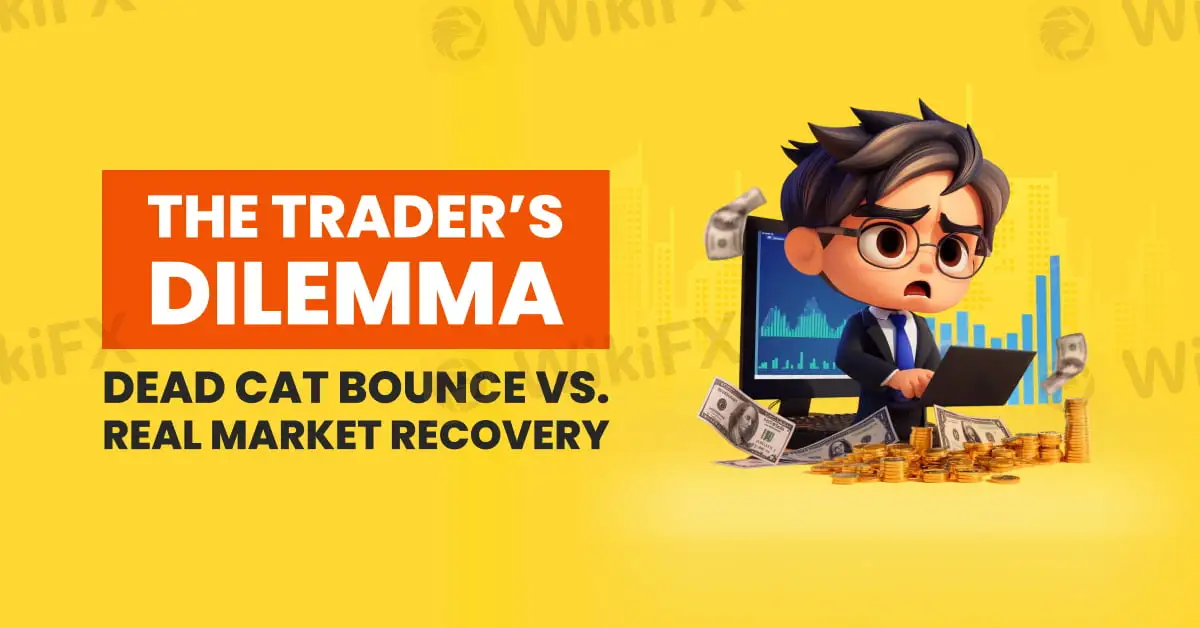简体中文
繁體中文
English
Pусский
日本語
ภาษาไทย
Tiếng Việt
Bahasa Indonesia
Español
हिन्दी
Filippiiniläinen
Français
Deutsch
Português
Türkçe
한국어
العربية
The Trader’s Dilemma: Dead Cat Bounce vs. Genuine Recovery
Abstract:One of the biggest challenges in trading is knowing whether a market is making a real comeback, or just fooling you. Many traders fall into the trap of thinking a falling stock or index has turned around, only to watch it fall again. How frustrating!

One of the biggest challenges in trading is knowing whether a market is making a real comeback, or just fooling you. Many traders fall into the trap of thinking a falling stock or index has turned around, only to watch it fall again. This short-lived rise is whats known as a dead cat bounce.
The term might sound strange, but it describes a common situation: after a big drop, prices suddenly go up for a short time, giving the impression that things are improving. But then they fall again, continuing the downtrend. On the other hand, a real reversal is when the market truly changes direction and starts a new trend (either up or down) for a longer period.

- Check the Trading Volume
Volume simply means how many people are buying and selling. If prices bounce back but not many people are trading, that move might not be strong. A real reversal usually comes with high volume, which is a sign that big players (like institutions) are stepping in with confidence.
- Look at the Bigger Picture
Dont just focus on one bounce. Step back and look at how the price has moved over time. If the price fails to move past a key level (like an old support or resistance point), it could be just a short-lived bounce. A real trend change often forms clear patterns, like a double bottom (a “W” shape) or a steady climb over days or weeks.
- Use Momentum Indicators
Tools like the Relative Strength Index (RSI) or MACD (Moving Average Convergence Divergence) can help show if momentum is building or fading. If the price is falling but these indicators are starting to rise, that might be a clue that the downtrend is losing steam, and a real reversal could be coming.
- Is There a Reason Behind the Move?
Always ask: Why is the price moving? A true reversal is often linked to big news, like strong earnings, a change in interest rates, or a major shift in market sentiment. A bounce without any clear reason might just be noise.
- Give It Time
This might be the hardest part, which is waiting. Real reversals take time to confirm. If you're too quick to jump in, you might get caught in a false move. It's often safer to wait for the price to break important levels (like moving averages) before acting.
Markets can be unpredictable. While learning to spot real reversals can make you a better trader, remember that no tool or signal is perfect.
Risk management should always come first. Never trade more than you can afford to lose, and always use stop-losses to protect yourself. Studying charts, news, and patterns can improve your chances, but every market move is different. What worked yesterday might not work tomorrow.
In trading, protecting your capital is the most important rule. Stay sharp, stay informed, and never stop learning.

Disclaimer:
The views in this article only represent the author's personal views, and do not constitute investment advice on this platform. This platform does not guarantee the accuracy, completeness and timeliness of the information in the article, and will not be liable for any loss caused by the use of or reliance on the information in the article.
Read more

Using Any of These Illegal Forex Trading Apps? Stop Before It Turns into a Crisis
The Reserve Bank of India (RBI) has listed out some illegal forex apps India. Read this article to know some of those apps.

IC Markets Sponsors AEL Limassol, Football Club Until 2027
AEL Limassol has renewed its deal with IC Markets (EU) Ltd, who will stay as the team’s Gold Sponsor until 2027. The sponsorship deal was first announced for the 2025–2026 season, but it has now been officially extended until 2027.

5 Reasons to Stay Away from Core Prime Markets
The Forex market is a very unpredictable, complex, and risky place. There are many brokers that appear genuine but can steal your hard-earned money. So, staying alert is the only way to survive in this dynamic environment. Therefore, in this article, we are sharing 5 warning signs about Core Prime Markets.

The Shame of Being Scammed: Don't Ever Stay Silent
It often starts with a promise of fast profits, low risk, and a slick-looking platform that seems too good to ignore. Before long, your savings are gone, the website vanishes, and so does the person who convinced you to invest. What’s worse? You never tell a soul. Every year, countless people fall into the trap of fraudulent investment schemes, yet most never speak up. Why? And what does this silence mean for the rest of us?
WikiFX Broker
Latest News
Asian chip stocks rise after Nvidia reclaims title of the world's most valuable company
Nvidia's comeback sparks a rally in Asian chip stocks
CNBC Daily Open: Despite all the uncertainty, the S&P 500 is flirting with record highs — strange times
PU Prime and AFA Announce Partnership at Madrid Event
eToro UK Launches 4% Stock Cashback Card: Earn Up to £1,500 Monthly
EBC Expands ETF CFD Offering & Copy Trading Education Partnership
Gold Prices Continue to Fall as Israel, Iran Agree on Ceasefire
China steps up push to internationalise the yuan as global dollar dominance wavers
Multibank Group Offices: Global Presence and Contact Info
ESMA Proposes Reporting Reforms That Could Cut Costs for Forex Brokers
Currency Calculator


